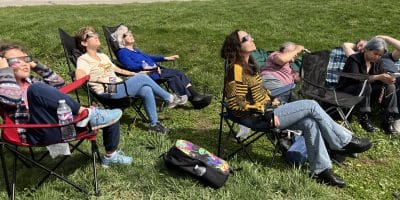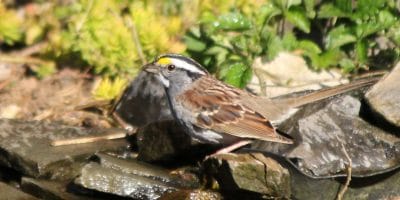
By Jeremiah Knupp, contributor
In his poem Manifesto: The Mad Farmer Liberation Front, Wendell Berry offers the following advice:
Invest in the millennium. Plant sequoias.
You could say Loren Hostetter’s passion is an East Coast version of that charge. The down payment he is placing on future centuries comes in the form of the seedlings that spring from a chestnut.
Hostetter’s involvement with the rebirth of the American chestnut tree started seven years ago when his daughter gifted him a membership to the American Chestnut Cooperators’ Foundation (ACCF), a non-profit based in Southwest Virginia. The group hopes to reverse the near disappearance of what was once the dominant tree in Eastern mountains and woodlands. In the early twentieth century, however, a fungus blight from Asia arrived in the region. In less than half a century, it wiped out nearly all the American chestnuts in their historic range.
“Over 3.5 billion trees were destroyed,” Hostetter noted. “It really is one of the largest ecological disasters ever recorded.”

A healthy American chestnut can grow over 100 feet tall with a diameter of up to six feet and live for several centuries. Historically ranging from Maine to Georgia, with concentrations along the Appalachian Mountains, the species once accounted for nearly a quarter of all of the trees in the region.
“It developed the ecosystem and was a huge benefit to wildlife and the early settlers and pioneers. It kept them alive, actually. [The nuts] were a very good source of protein and carbohydrates. It allowed them to survive a lot of hard winters,” Hostetter said. “Every animal loves the chestnut, from bears to squirrels to raccoons, so it was just a large part of the ecosystem that was lost during the decades of the 1930s to the 1940s.”
More than just a food source, the chestnut tree was the material that Appalachian lives were constructed with. Its light, strong, rot-resistant wood found its way into everything from handmade furniture to split-rail fences (to learn more about the complete history of the American chestnut and its importance, watch this short documentary by Eco-Outpost).
Groups like the ACCF believe that American chestnuts can thrive once again. A few mature trees throughout the region have survived due to a natural blight resistance. The group uses the genetics of these trees to create a hardy strain of American chestnuts. The offspring are in their third generation of development and are spread through the cooperative’s network of citizen scientists.
“They provide the nuts to volunteer cooperative members,” Hostetter said. “We plant those nuts and then will eventually report on the resistance of each strain. The more I read, the more I decided to go far beyond and set up controlled studies and assist the cooperative with robust monitoring and documentation.”

Chestnut trees are popular with landowners in the area, though most are commercial hybrids where American trees are crossed with Asian varieties for blight resistance. This makes for a challenge for those wanting to foster pure American chestnut genetic strains and don’t want cross-pollination from hybrids growing on neighboring properties.
“We’re sort of the purists,” Hostetter said. “This biodiversity was all but destroyed. How do we go back and make sure that for future generations we haven’t lost that? We have an obligation to atone for the mistakes of our generation or earlier generations. We lost a treasure, so let’s try to bring it back where and when we can.”
While American chestnuts can grow nearly anywhere on the East Coast, they thrive best in certain types of soils and on the eastern-facing slopes of mountain ridges. Hostetter chose as his planting site a plot of land owned by his family in the Hopkins Gap area west of Harrisonburg. He calls it his “last resort.”

His original goal was to plant his seedlings in Shenandoah National Park.
“I had a vision early on to say, ‘This is a national heritage and it dominated the Shenandoah National Park like everywhere else. Why can’t we bring it back to the park and in that process we tell the story of what happened and educate the public on the ongoing introduction of exotic and invasive species, using this as a positive story about why we have such need to be careful,’” Hostetter said. “[With Shenandoah National Park] we know that we’ve got a real big footprint that is protected and isolated from any potential cross. Long-term we need a sizeable chunk of land and Shenandoah National Park is one of the best opportunities, I think, for future generations to protect that biodiversity.”
In an email, Jake Hughes, invasive plants/restoration biologist with Shenandoah National Park, said that species reintroduction on national parks land often involves collaboration with an out side group. On example that he pointed to is the effort to re-establish breeding populations of the peregrine falcon in the Park in cooperation with a conservation center at the College of William & Mary.
“Paraphrasing from National Park Service Management policies, the parks will reintroduce native species if sufficient habitat exists (or can be restored) to support the species, the genetic makeup of the re-introduced organisms is as close as possible to that of the extirpated ones, the disappearance (or, in the case of the chestnut, reduction) of the species has occurred due to human activities, and potential impacts to the park (other natural and cultural resources, management, use) have been analyzed and are acceptably low,” Hughes wrote.
The first step in the process is applying for a research permit. While Hostetter’s initial request was denied due mainly to the park’s concerns of the purity of the genetics of his trees, he was not deterred. Hostetter is using his current test plot to demonstrate and document that he can successfully raise genetically pure trees.

Seven years into the project, some of Hostetter’s trees are at their make-or-break point. The blight doesn’t “kill” American chestnuts outright. Throughout public (including Shenandoah National Park) and private lands on the East Coast, new tree sprouts still break through the soil every spring from the root stock of trees attacked by the blight. When the new chestnuts nearly reach their reproductive maturity, around the seventh or eighth year of their life, the blight strikes. Though they may be six inches in diameter and stand 20 to 25 feet high, the fungus gets into wounds in the bark near the base of the tree and destroys all of the plant above it. To verify that a tree is resistant, it must first get the blight and then prove that it can fight it off. This is demonstrated when the tree develops blight cankers and then successfully heals them over.
To move the project forward, Hostetter is looking for other planting sites on private property to continue expanding his network of people interested in American chestnuts.
“We’d love to work with anyone. I’m really interested in building a cadre of champions that appreciates what was done and what we can do, so whether it’s a homeowner in a city lot or somebody who has acreage in the forest, I’d love to make contact,” he said. “We’re setting our case and continuing to show that we’re serious and have a robust process, but eventually, we want to get to the Park. These private plantings strengthen our case.”

One of the first steps in building that coalition happened on the last Saturday in February when four Eastern Mennonite School (EMS) students, as well as former EMS science teacher Lee Good, joined Hostetter to put 36 more seedlings in the ground. Good, who is friends with Hostetter, helped coordinate the involvement of the EMS students, who are members of the school’s environmental club.
“It just gives the students hope,” Good said. “When the wheels seem to be coming off, here’s an example of someone working really hard to try and envision what a future that looks better than today might look like.”
Good plans to return to the site with the students in May to see how their seedlings are progressing. Hostetter hopes to eventually involve not just EMS, but also Eastern Mennonite University to help with the research. It’s all part of his plan to prove the viability of re-introducing American chestnuts to Shenandoah National Park. According to Hughes, Shenandoah National Park is not actively considering a re-introduction of American chestnuts, but park staff are monitoring developments in the field, such as gene-splicing techniques that can add blight resistance to a tree’s genome.
Even if a thriving population of American chestnuts develops, will the Eastern forests ever return to their pre-20th century glory?
“Because the forest compensates, now you’ve got basically an oak forest. Nature’s got its own ways of figuring that out,” Hostetter said. “How well could chestnuts now come in and reclaim their dominance? We’d certainly like to give it a chance and get pockets [of trees] out there and see what Nature does to readjust.”
“Given the time it would take to establish millions of canopy trees, and the potential impacts of climate change on park forests, it’s tough to say with much confidence that American chestnut could be restored to its former glory in Shenandoah [National Park],” Hughes said. “But it’s certainly exciting to think about!”

The American chestnut is just one example of how native plants and animals, and even food crops, can be affected by invasive plants, animals and diseases.
“Our point is to use this example in a positive story to say ‘We’ve got to be diligent, as a population, to guard what we have — our natural heritage,’” Hostetter said.
There are even larger lessons to be learned in this time of a global pandemic.
“Certainly the pandemic shows that it’s not just an obscure tree or plant that we might lose and everybody can shrug it off,” Hostetter said. “What happened in the pandemic to us is exactly what happened to the chestnut. Something runs rampant because of carelessness, because we really didn’t pay attention to our biosphere.”
Berry concludes his poem that opens this story with a simple line: “Practice resurrection.” In a mountain hollow just west of Harrisonburg, a re-birth is happening, one American chestnut seedling at a time. If all goes according to plan, the trees recently planted will outlive the youthful hands that placed them in the ground.
Those interested in working with Hostetter on his American chestnut project can contact him by email.
Journalism is changing, and that’s why The Citizen is here. We’re independent. We’re local. We pay our contributors, and the money you give goes directly to the reporting. No overhead. No printing costs. Just facts, stories and context. We’re also a proud member of the Virginia Press Association. Thanks for your support.












